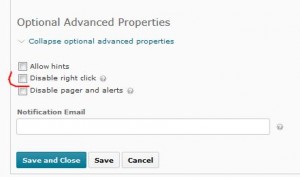Archive of ‘cheating’ category
Do we need to pay for services such as Turnitin?
Are there comparable services for free?
Do we need services such as those ones or we rather have faculty and students educated on plagiarism and faculty trained to detect plagiarism?
Is it supposed to be a “mechanical” process or educational activity?
These questions following a posting of today from the Educause Blended and Online Learning Group
Are any of you using a non-Turnitin plagiarism checker that you’re happy with (besides Google or Grammarly’s free service)?
Thanks,
Jenn Stevens (
she, her, hers)
Director, Instructional Technology Group
403C Walker Building
Emerson College | 120 Boylston St | Boston, MA 02116
(617) 824-3093
At Ursinus, we use PlagScan, which is affordable and meets our needs.
We haven’t been able to get it to fully integrate within our LMS yet but hopefully we will be able to soon.
Christine Iannicelli
Instructional Technology Librarian
Library and IT
Library 124
Phone: 610-409-3466
ciannicelli@ursinus.edu
++++++++++
more on TurnitIn in this IMS blog
https://blog.stcloudstate.edu/ims?s=turnitin
more on alternatives and Grammarly
https://blog.stcloudstate.edu/ims?s=grammarly
https://blog.stcloudstate.edu/ims/2017/08/16/grammarly-alternatives/
Artificial Intelligence Can Unlock Fingerprint Scanners
++++++++++++++++
more on AI in this IMS blog
https://blog.stcloudstate.edu/ims?s=artificial+intelligence
Digital Proctoring
I great exchange on ideas regarding digital proctoring in the Blended and Online Learning listserv:
https://www.proctortrack.com/
David Huckleberry
Coordinator of Digital Instruction – Physics & Astronomy
Purdue University
Office = PHYS 176
525 Northwestern Avenue
West Lafayette, IN 47907
dhuckleb@purdue.edu
++++++++++++
Proctorio
Scott Robison, Ph.D.
Associate Director, Digital Learning and Design
Portland State University
Portland, OR 97201
503-725-9118
@otterscotter
+++++++++++++++++
At University of Wisconsin – Superior – we have stopped offering proctoring for students. Faculty, however, have come up with a way for online testing. They ask student to use Kaltura tto record their face and part of the test and then post the video in the dropbox.
Rebecca Graetz, EdD
Instructional Program Manager II
UW – Superior
rgraetz@uwsuper.edu
++++++++++++
ProctorU, an online proctoring service, with online courses that offered online exams and BioSig ID for courses that did not require exams.
Kelvin Bentley
Twitter: blacktimelord
++++++++++++++
+++++++++++++
more on proctoring in this IMS blog
https://blog.stcloudstate.edu/ims?s=proctoring
Wiklund, M., Mozelius, P., Westing, T., & Norberg, L. (2016). Biometric Belt and Braces for Authentication in Distance Education. Retrieved from
https://www.researchgate.net/publication/309548915_Biometric_Belt_and_Braces_for_Authentication_in_Distance_Education
Abstract
a need for new techniques to handle the problem in online environments. To achieve zero cheating is hard (or impossible) without repelling not only cheaters but also those students who do not cheat, where a zero ‐ tolerance emphasis also would risk inhibiting students’ intrinsic motivation. Several studies indicate that existing virtual learning environments do not provide the features needed to control that the intended student is the one taking the online exam. Biometric Belt and Braces for Authentication in Distance Education.
One approach to prevent student’s dishonesty is the university code of honour. This is a set of rules describing what actions are not permitted and the consequences for students taking such actions. Another way of preventing cheating is the use of proctors during written exams. Even while using such codes of honour and proctors, universities still have found many students to cheat. Biometric Belt and Braces for Authentication in Distance Education.
Neutralisation is the phenomenon when a person rationalises his or her dishonest behaviour with arguments like “I can do this because the work load within this course is just too overwhelming” or “I can do this because I have a half ‐ time job on the side which gives me less study time than the other students have”. By doing so the student puts the blame for cheating on external factors rather than on himself, and also protects himself from the blame of others (Haines et al. 1986). This neutralises the behavior in the sense that the person’s feelings of shame are reduced or even eliminated. Haines et al. (1986 Biometric Belt and Braces for Authentication in Distance Education.
Simply asking participants to read a code of honour when they had the opportunity to cheat reduced dishonesty. Also whether one signed the code of honour or just read it influenced cheating. The Shu et al. (2011) study suggests that opportunity and knowledge of ethical standards are two factors that impact students’ ethical decision about cheating. This is in line with the results in (McCabe, Trevino and Butterfield 2001), showing that if students regularly are reminded of the university’s code of honour, they are less likely to cheat Biometric Belt and Braces for Authentication in Distance Education.
For an online course setting, Gearhart (2001) suggest that teachers should develop a guideline for “good practices”.
In online examination there are reports of students hiring other persons to increase their scores (Flior & Kowalski, 2010) and there is a need for new enhanced authentication tools (Ullah, Xiao & Lilley, 2012). For companies and Internet environments the process of authentication is often completed through the use of logon identification with passwords and the assumption of the password to guarantee that the user is authentic (Ramzan, 2007), but logins and passwords can be borrowed (Bailie & Jortberg, 2009). The discussion on how to provide enhanced authentication in online examination has led to many suggested solutions; four of them are: Biometric Belt and Braces for Authentication in Distance Education.
- Challenge Questions: with questions based on third ‐ party data
- Face ‐ to ‐ Face Proctored Exam: with government or institution issued identification
- Web Video Conference Proctor: audio and video conference proctoring via webcam and screen monitoring service with live, certified proctors
- Biometrics and Web Video Recording: with unique biometrics combined with the recording of student in exam via webcam
An idea for online courses is that assessment should not only be a one way process where the students get grades and feedback. The examination process should also be a channel for students’ feedback to teachers and course instructors (Mardanian & Mozelius, 2011). New online methods could be combined with traditional assessment in an array of techniques aligned to the learning outcomes (Runyon and Von Holzen, 2005). Examples of summative and formative assessment in an online course could be a mix of: Biometric Belt and Braces for Authentication in Distance Education.
- Multiple choice questions (MCQ) tests, automatically corrected in a virtual learning environment
- Term papers or essays analysed by the course instructors
- Individual or group assignments posted in digital drop ‐ boxes
- Oral or written tests conducted in the presence of the instructor or through videoconferences (Dikli, 2003)
Authors’ suggestion is a biometric belt and braces model with a combination of scanned facial coordinates and voice recognition, where only a minimum of biometric data has to be stored. Even if the model is based on biometrics with a medium to low grade of uniqueness and permanence, it would be reliable enough for authentication in online courses if two (or more) types of biometrics are combined with the presented dialogue based examination using an interaction/obser ‐ vation process via web cameras. Biometric Belt and Braces for Authentication in Distance Education.
++++++++++++++++++
more on identification in this IMS blog
https://blog.stcloudstate.edu/ims?s=identification
++++++++++++++++
more on proctoring and detecting cheating:
http://www.wgu.edu/blogpost/innocent-red-flags-caught-by-online-exam-proctors
voices from the other side:
http://infoproc.blogspot.com/2013/04/how-to-cheat-online-exam-proctoring.html
https://campustechnology.com/articles/2016/04/06/how-students-try-to-bamboozle-online-proctors.aspx
http://www.usnews.com/education/online-education/articles/2014/06/17/think-twice-before-cheating-in-online-courses
How to Enable the Right Click on Websites That Disable It
, it seems that it is feeble option for proctoring, if the Web shares plenty of information how to circumvent right-click
+++++++++
more on proctoring in this IMS blog:
https://blog.stcloudstate.edu/ims?s=proctor
Cheating Inadvertently
http://chronicle.com/article/Cheating-Inadvertently/229883/
2001 article that illustrated nicely the challenge we face in helping students do their work with integrity.
the form of plagiarism continues into graduate school, where plagiarism remains, by far, the most common form of academic dishonesty.
the article repeats to a degree what is already known:
http://web.stcloudstate.edu/pmiltenoff/plagiarism/index.html
http://web.stcloudstate.edu/pmiltenoff/plagiarism/convocation2008.ppsx
namely, that plagiarism is in a much smaller degree intentional and to its largest percentage lack of systematic approach and clear directions by faculty toward students.
Rebecca Moore Howard, a professor of writing and rhetoric at Syracuse University, has called “patchwriting,” or borrowing large sentence structures and vocabularies from a source and only swapping out the occasional word or phrase with language of their own.
academic integrity represents an incredibly complex subject to master: It encompasses knowledge (What are the rules of academic integrity? How do they apply in this context?), skills (How do I summarize or paraphrase this passage without plagiarizing? How do I credit the work of others when I am collaborating with peers or using sources?), and values (Why does academic integrity matter? Why should I care about it?).
“Those who do not want to imitate anything, produce nothing.”
― Salvador Dalí
| This email is in regard to a feature within D2L that may be exploited by students to cheat on quizzes and exams.SUMMARY
D2L allows students to re-enter a quiz after leaving the quiz for any reason. This feature is useful for recovering from internet connection problems or other disruptions. This feature can be exploited by two students, one in the classroom and one outside of the classroom, to enter a quiz or exam in quick succession. The second student (the re-entrant student) can then take the quiz on behalf of the student in the classroom while both are connected to the same quiz. The instructor can make such collaboration difficult but cannot completely prevent it. |
 |
ACTIONS
We are actively investigating along with D2L methods of addressing this issue. We don’t expect to be able to completely prevent such behavior due to undesirable consequences for other students, but we are working on detecting it so appropriate notifications can be made and action can be taken quickly.
If you need more information on the issue, prevention, and possible solutions, please contact your local D2L System Administrator or Dick McMullen at dick.mcmullen@so.mnscu.edu or Chuck Morris at Chuck.Morris@so.mnscu.edu.
Sheri Steinke, Ph.D.
Director of Online Learning
Adjunct Faculty CIM & BUSN, CSCI
Certified Quality Matters™ Online Trainer and Peer Reviewer
(952)358-8802
Sheri.Steinke@normandale.edu
Nice short visual online tutorial, which can help with ideas…:
http://www.uwlax.edu/catl/instructionaldesign/cheating_tutorial/engage.html

